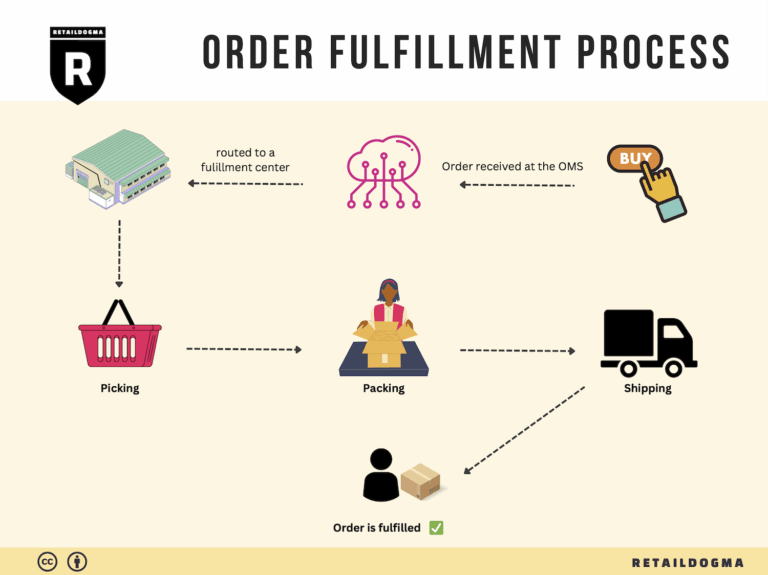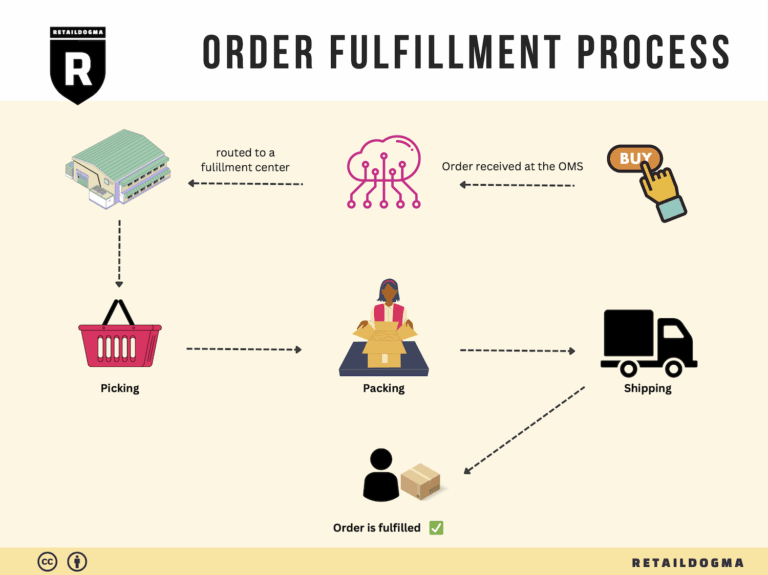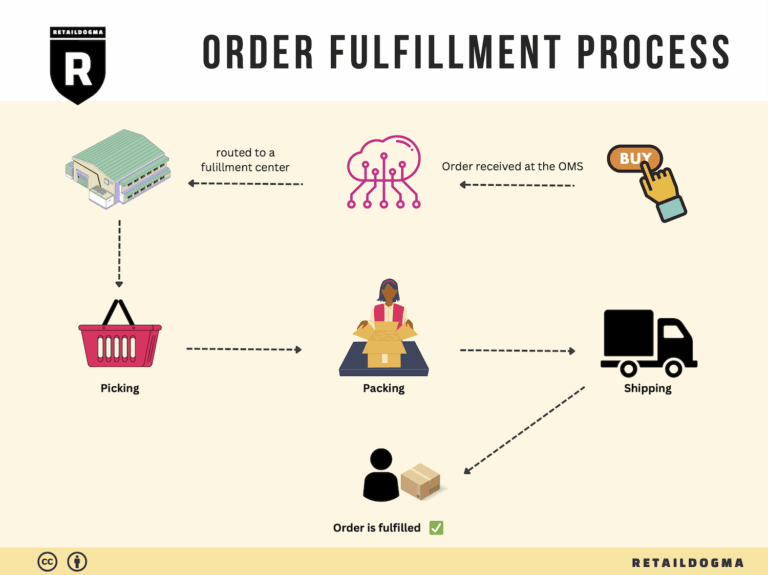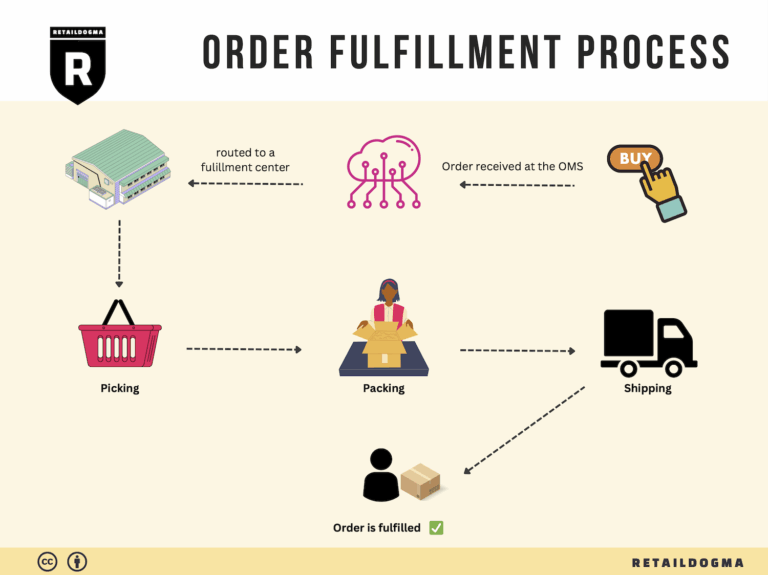Ecommerce Fulfillment Services: The Ultimate Guide (2025)
What is E-commerce Fulfillment? An Introduction for Growing Businesses
Understanding E-commerce Fulfillment
As an e-commerce business owner, you may find yourself overwhelmed by the logistics of packing and shipping orders. Managing the fulfillment process can become a significant challenge, particularly as your sales grow. The pressure to ensure timely delivery and maintain customer satisfaction can be daunting. This is where the concept of fulfillment becomes crucial. Simply put, fulfillment is the entire process of getting a product from your inventory to your customer’s doorstep. It encompasses everything from receiving and storing products to packing and shipping orders.
In this guide, we will delve into the various models of e-commerce fulfillment that can help you scale your operations effectively. You’ll learn about Third-Party Logistics (3PL) providers, which can handle warehousing and shipping for you, and Fulfillment by Amazon (FBA), a service that allows you to leverage Amazon’s vast network for storage and delivery. Each model has its unique advantages and considerations, and understanding them can help you make informed decisions about your logistics strategy.
We will also cover the core services involved in fulfillment. These include inventory management, order processing, packaging, shipping, and returns handling. Knowing what services are available will enable you to choose the right fulfillment partner based on your specific needs and customer expectations.
Selecting the right fulfillment partner is another critical aspect we will discuss. Factors such as reliability, technology integration, customer service, and geographical reach should be considered to ensure that your fulfillment process aligns with your business goals. We will provide practical tips on what to look for when evaluating potential partners.
Lastly, pricing is a vital component of your fulfillment strategy. We will break down the typical costs associated with different fulfillment models and services, helping you understand how to budget effectively for your logistics needs.
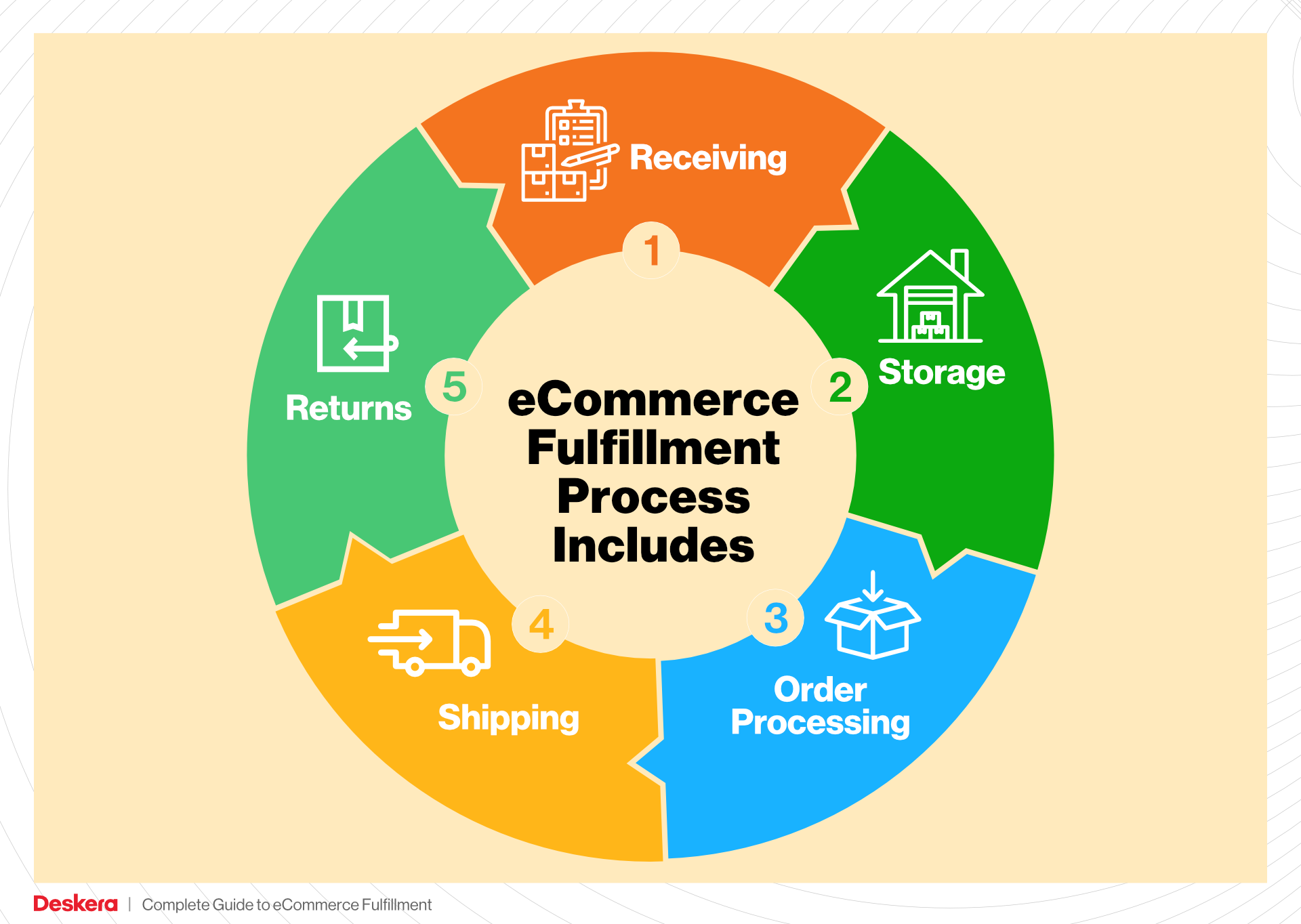
The ultimate goal of this guide is to empower your business to make smart, strategic decisions about your logistics operations. By understanding the fundamentals of e-commerce fulfillment, you can streamline your processes, reduce overhead costs, and enhance customer satisfaction, all of which are essential for sustained growth in the competitive e-commerce landscape.
What You’ll Learn In This Guide
- What is E-commerce Fulfillment? An Introduction for Growing Businesses
- The Order Fulfillment Process: From ‘Buy’ Button to Customer’s Door
- Comparing Fulfillment Models: In-House vs. 3PL vs. Dropshipping
- A Deep Dive into Amazon FBA: Pros, Cons, and Who It’s For
- Core Services Offered by Fulfillment Centers
- How to Choose a Fulfillment Partner: A 6-Point Checklist
- Understanding Fulfillment Pricing: A Breakdown of Common Fees
- Frequently Asked Questions (FAQs) about Fulfillment
- Conclusion: Is Outsourcing Fulfillment the Right Move for Your Business?
- Important Disclaimer
The Order Fulfillment Process: From ‘Buy’ Button to Customer’s Door
1. Receiving Inventory
The order fulfillment process begins with receiving inventory. When products arrive at the Amazon Fulfillment Center, they undergo a thorough inspection to ensure quality and accuracy. Each item is checked against purchase orders to confirm that the correct quantities and types of goods have been delivered. This step is critical because it prevents discrepancies that could lead to inventory shortages or overages, which can disrupt the entire supply chain.
A key term associated with this stage is SKU (Stock Keeping Unit). Each product is assigned a unique SKU that allows for easy tracking and management. Properly received inventory is crucial for maintaining an accurate inventory count, which directly impacts order fulfillment efficiency and customer satisfaction. If items are not received correctly, it can lead to delays in order processing and ultimately affect the customer experience.
2. Warehouse Storage
Once inventory has been received and verified, the next step is warehouse storage. Products are organized and stored in designated locations within the fulfillment center. This organization can involve various strategies, such as random storage or zone storage, where products are placed in specific areas based on their demand.
Efficient warehouse storage is important because it maximizes space utilization and streamlines the picking process. A term that is often used in this context is FIFO (First In, First Out). This inventory management method ensures that older stock is sold before newer stock, which is especially important for perishable goods.
Effective storage solutions not only enhance operational efficiency but also reduce the time it takes to locate products during the order picking phase. A well-organized warehouse contributes to faster order fulfillment, which is essential for meeting customer expectations in today’s fast-paced e-commerce environment.
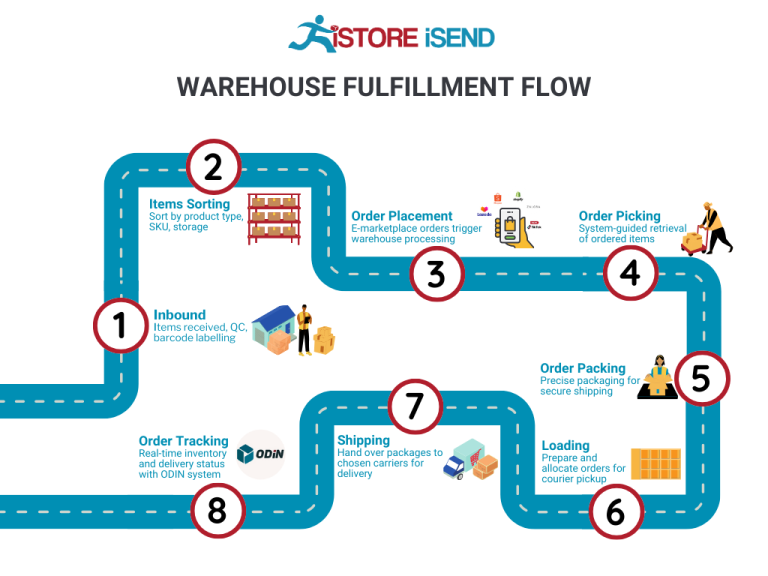
3. Order Picking
Order picking is the stage where items are selected from their storage locations to fulfill customer orders. This process is typically guided by a pick list, which is a document or electronic list that outlines the items and quantities needed for each order. Workers use this list to navigate the warehouse efficiently and gather the required products.
The importance of order picking cannot be overstated; it directly affects the accuracy and speed of order fulfillment. Any mistakes made during this stage can lead to incorrect orders being shipped, resulting in returns and diminished customer satisfaction. To enhance picking efficiency, many fulfillment centers implement technologies such as barcode scanning and automated picking systems.
The speed and accuracy of order picking are vital for maintaining a competitive edge in the e-commerce landscape. As customers increasingly expect faster delivery times, optimizing this step can significantly impact overall fulfillment performance.
4. Order Packing
Once the items have been picked, they move to the packing stage. Here, products are carefully packed into shipping boxes or envelopes, ensuring they are protected during transit. This step is crucial for preventing damage and ensuring that items arrive in excellent condition.
A key term associated with order packing is packing slips, which are included in the shipment to inform customers about the contents of their package. Proper packing not only safeguards the products but also enhances the unboxing experience for the customer, which can positively influence brand perception.
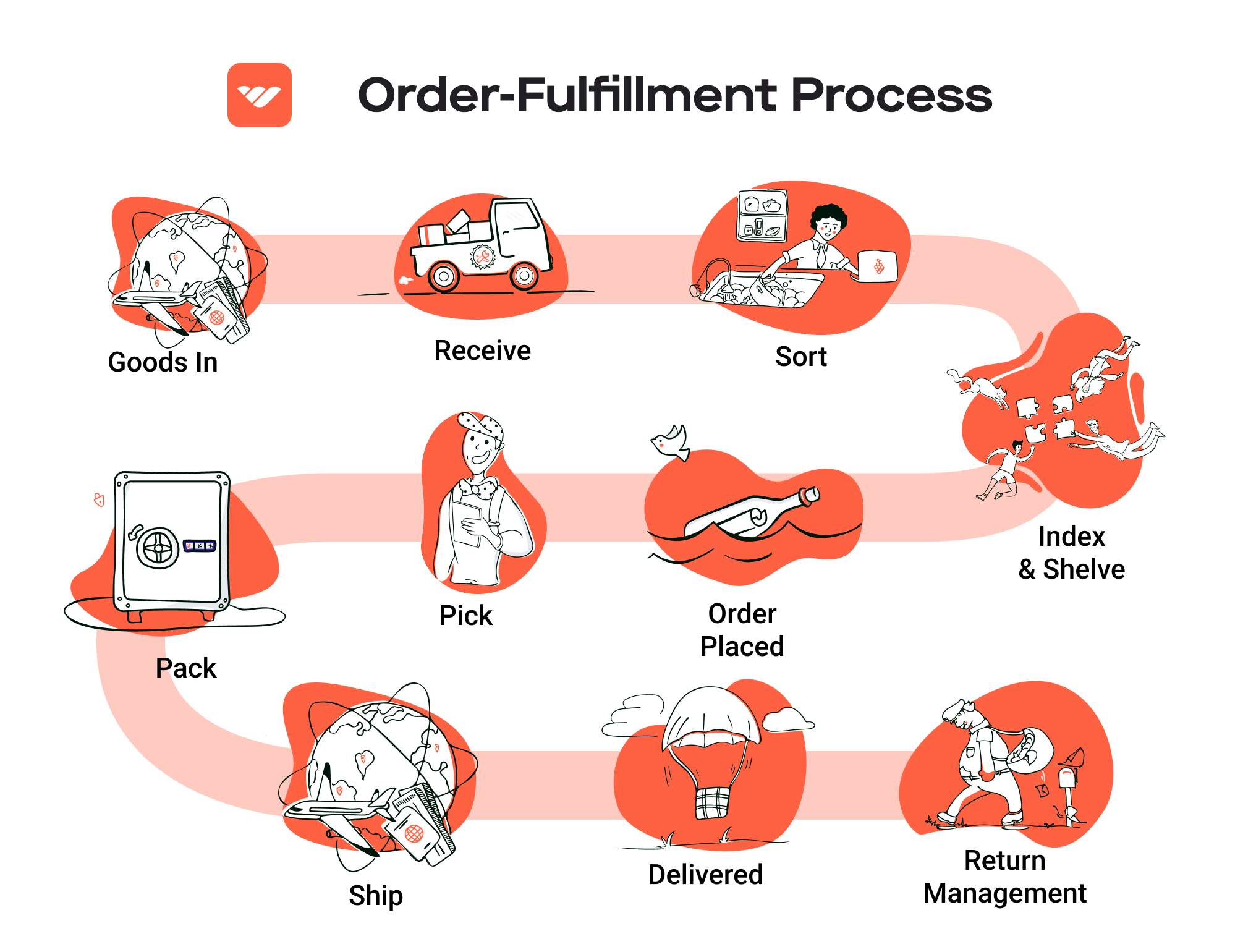
Effective packing processes also consider shipping costs. By optimizing the size and weight of packages, businesses can reduce shipping expenses while still providing adequate protection for the products. Thus, a well-executed packing operation is essential for both customer satisfaction and cost management.
5. Shipping & Delivery
The final step in the order fulfillment process is shipping and delivery. Once orders are packed, they are labeled and prepared for dispatch. This stage involves coordinating with shipping carriers to ensure timely delivery to the customer’s doorstep.
A vital term in this phase is last-mile delivery, which refers to the final leg of the shipping journey from a distribution center to the customer’s home. Last-mile delivery is often the most complex and costly part of the shipping process, making it a focal point for logistics optimization.
Efficient shipping and delivery are crucial for customer satisfaction. In today’s e-commerce landscape, customers expect quick and reliable delivery options. Businesses that excel in this area can enhance their reputation and foster customer loyalty. By leveraging advanced tracking systems and strategic partnerships with carriers, companies can improve their shipping efficiency and provide customers with real-time updates on their orders.
In conclusion, understanding and optimizing each step of the order fulfillment process—from receiving inventory to shipping and delivery—can significantly enhance operational efficiency and customer satisfaction. By focusing on these critical areas, e-commerce businesses can scale effectively and meet the demands of an ever-evolving marketplace.
Comparing Fulfillment Models: In-House vs. 3PL vs. Dropshipping
Fulfillment Models Overview
Understanding the various fulfillment models is crucial for e-commerce business owners and operations managers looking to scale their logistics efficiently. The choice between In-House Fulfillment, Third-Party Logistics (3PL), and Dropshipping can significantly impact operational costs, inventory management, and customer satisfaction. Below is a comparative analysis of these models:
| Model | Who Handles Inventory | Best For (Business Stage) | Key Advantage | Key Disadvantage |
|---|---|---|---|---|
| In-House Fulfillment | The business itself | Established businesses with stable sales | Full control over inventory and processes | High operational costs and complexity |
| Third-Party Logistics (3PL) | A specialized logistics provider | Startups to mid-sized businesses | Scalability and expertise in logistics | Less control over inventory and processes |
| Dropshipping | Suppliers and manufacturers | Startups and entrepreneurs | Low upfront investment and risk | Lower profit margins and reliance on suppliers |
In-House Fulfillment
In-House Fulfillment involves the business managing its own inventory, packing, and shipping processes. This model is typically best suited for established businesses with stable sales and a clear understanding of their customer demand. One of the primary advantages of in-house fulfillment is the control it provides over inventory management and logistics processes. Businesses can implement tailored fulfillment strategies, ensuring quality and speed in order processing. Additionally, having direct oversight allows for better customer service and the ability to respond quickly to any issues.
However, the key disadvantage is the significant operational costs associated with maintaining a warehouse and staffing a fulfillment team. Businesses need to invest in technology, space, and human resources, which can complicate operations, especially as they scale. For smaller businesses or startups, this model may present a barrier to entry due to the high initial investment and ongoing expenses.
Third-Party Logistics (3PL)
Third-Party Logistics, or 3PL, involves outsourcing the logistics operations to a specialized provider. This model is ideal for startups and mid-sized businesses that need to scale quickly without the burdens of managing inventory and fulfillment themselves. The key advantage of 3PL is the scalability it offers; businesses can easily adjust their logistics capabilities based on demand fluctuations. Additionally, 3PL providers often have advanced logistics expertise and technology, allowing businesses to benefit from optimized shipping, reduced costs, and improved delivery times.
On the flip side, the main disadvantage of using a 3PL is the reduced control over inventory and fulfillment processes. Businesses must rely on their logistics partner to maintain quality standards and meet delivery deadlines. This can lead to potential misalignments with brand expectations or customer service issues if the 3PL provider does not perform to the desired level. Furthermore, as businesses grow, they may find themselves facing increasing fees or contracts that can limit flexibility.
Dropshipping
Dropshipping is a fulfillment model where the retailer does not hold inventory but instead relies on suppliers to ship products directly to customers. This model is particularly attractive for startups and entrepreneurs looking to enter the e-commerce space with minimal upfront investment and risk. The key advantage of dropshipping is the low overhead costs; businesses can offer a wide range of products without the need to invest in inventory upfront. This flexibility allows entrepreneurs to test different products and markets with reduced financial exposure.
However, dropshipping also comes with its challenges. One of the primary disadvantages is the lower profit margins, as retailers often have to pay a premium for the convenience of not holding inventory. Additionally, dropshipping relies heavily on suppliers for product quality and shipping speed, which can lead to inconsistencies in customer experience. If a supplier fails to deliver on time or provides a subpar product, it reflects poorly on the retailer, potentially damaging their reputation and customer trust.
Conclusion
Choosing the right fulfillment model is a critical decision that can influence the scalability and operational efficiency of an e-commerce business. Each model—In-House Fulfillment, Third-Party Logistics, and Dropshipping—offers unique advantages and disadvantages, making it essential for business owners to align their choice with their operational capabilities, financial resources, and growth objectives. By carefully evaluating these factors, entrepreneurs can select a fulfillment strategy that supports their long-term success in the competitive e-commerce landscape.
A Deep Dive into Amazon FBA: Pros, Cons, and Who It’s For
Understanding Fulfillment by Amazon (FBA)
Fulfillment by Amazon (FBA) is a service offered by Amazon that allows e-commerce sellers to store their products in Amazon’s fulfillment centers. Amazon takes care of storage, packaging, and shipping, as well as customer service and returns for these products. This service is designed to help sellers manage logistics more efficiently while leveraging Amazon’s extensive distribution network.
How FBA Works
- Account Setup: Sellers start by creating an Amazon Seller account and enrolling in FBA.
- Product Listing: Once enrolled, sellers can create product listings on Amazon. They indicate which products they want to fulfill through FBA.
- Inventory Shipment: Sellers ship their products to Amazon’s fulfillment centers. Amazon provides guidelines on packaging and labeling to ensure smooth processing.
- Storage and Management: Once the products arrive at the fulfillment center, Amazon stores them until they are sold. Sellers can track inventory levels through their Seller Central dashboard.
- Order Fulfillment: When a customer places an order, Amazon picks, packs, and ships the product directly to the customer. This process is facilitated by Amazon’s advanced logistics systems, ensuring fast delivery.
- Customer Service: Amazon handles customer inquiries and returns, providing a seamless experience for both sellers and buyers.
- Payment Processing: Sellers receive payments for their sales, minus Amazon’s fees, which are deducted automatically.
Pros of Using FBA
-
Prime Eligibility: One of the most significant advantages of FBA is that products fulfilled by Amazon are eligible for Amazon Prime. This increases visibility and can significantly boost sales as Prime members are more likely to purchase products with free, fast shipping.
-
Customer Trust: Leveraging Amazon’s brand reputation, products fulfilled through FBA instill greater confidence in customers. The assurance of Amazon’s customer service and easy return policies can lead to higher conversion rates.
-
Multi-Channel Fulfillment: FBA isn’t limited to Amazon’s marketplace. Sellers can use FBA to fulfill orders from their own websites or other sales channels, streamlining operations and maintaining consistent inventory management.
-
Scalability: FBA allows sellers to scale their operations without the need to invest in warehousing, staffing, and logistics. As sales grow, sellers can simply send more inventory to Amazon.
-
Time-Saving: Outsourcing fulfillment to Amazon allows sellers to focus on other critical aspects of their business, such as marketing and product development, rather than logistics.
Cons of Using FBA
-
High Fees: While FBA provides many benefits, it comes at a cost. Sellers must pay various fees, including storage fees for inventory held at Amazon and fulfillment fees for each order shipped. These costs can add up, especially for lower-margin products.
-
Strict Inventory Rules: Amazon has stringent rules regarding inventory management. Sellers must monitor their stock levels closely, as excess inventory can lead to increased storage fees, and low stock can result in lost sales.
-
Commingling Risks: When sellers choose to commingle their inventory with other sellers’ products, there is a risk of receiving returns or issues related to damaged or defective items that do not belong to them. This can lead to complications and potential loss of customer trust.
-
Limited Control Over Fulfillment: Sellers give up a degree of control over how their products are packaged and shipped. This can impact branding opportunities and customer experience, as packaging may not align with the seller’s branding.
-
Complex Returns Process: While Amazon handles returns for FBA sellers, the process can sometimes be less transparent for sellers, complicating inventory management and leading to potential financial losses.
Who is FBA Best For?
Fulfillment by Amazon is ideal for a variety of sellers, particularly:
-
Small to Medium-Sized Businesses: Those looking to scale quickly without the burden of managing logistics and fulfillment can greatly benefit from FBA.
-
E-commerce Entrepreneurs: New sellers wanting to leverage Amazon’s extensive customer base and logistics capabilities to gain traction in the competitive online marketplace.
-
Brands Seeking Exposure: Businesses looking to increase brand visibility and credibility can take advantage of Amazon’s marketplace, particularly through Prime eligibility.
-
Sellers with Diverse Product Lines: Those who offer multiple products and want to simplify their logistics by centralizing fulfillment can find FBA a suitable solution.
-
Seasonal Sellers: Businesses with seasonal products can benefit from FBA without the long-term commitment of a warehouse lease, allowing them to manage inventory effectively during peak times.
In conclusion, FBA offers a robust solution for e-commerce businesses looking to scale efficiently while providing a reliable customer experience. However, potential sellers must weigh the benefits against the costs and operational challenges to determine if it aligns with their business goals.
Core Services Offered by Fulfillment Centers
Inventory Management & Warehousing
Inventory management and warehousing form the backbone of effective fulfillment operations. Fulfillment centers like Amazon’s in Deltona provide businesses with a dedicated space to store their products, ensuring they have the right stock levels available to meet customer demand.
This service involves sophisticated inventory tracking systems that monitor stock levels in real-time. These systems help e-commerce businesses avoid stockouts or overstock situations, which can lead to lost sales or increased holding costs. By utilizing advanced technology, fulfillment centers can automate inventory updates, providing businesses with accurate data on product availability.
The benefits of efficient inventory management include improved cash flow, as businesses can better align their purchasing with actual sales trends. Additionally, this service enhances order accuracy and customer satisfaction, as products are readily available for timely fulfillment. For e-commerce entrepreneurs, leveraging the warehousing capabilities of fulfillment centers allows them to focus on scaling their business without the burden of managing a physical storage space.
Pick and Pack Services
Pick and pack services are integral to the fulfillment process, where the fulfillment center is responsible for selecting products from inventory (picking) and preparing them for shipment (packing). This process is crucial for ensuring that customer orders are fulfilled accurately and efficiently.
In a fulfillment center like Amazon’s, trained associates use technology to streamline the picking process, often utilizing barcode scanners and automated systems to quickly locate and retrieve items. Once items are picked, they are packed securely for shipping, often using materials that protect products during transit.
The benefits of pick and pack services include reduced order processing time and increased order accuracy. E-commerce businesses can expect faster delivery times, which is a significant competitive advantage in today’s market. Furthermore, outsourcing these tasks to fulfillment centers allows businesses to scale operations without the need to hire additional staff or invest in packing equipment, thus minimizing operational costs.
Kitting and Assembly
Kitting and assembly services involve the grouping of individual items into ready-to-ship sets or the assembly of products that require multiple components. This service is particularly valuable for businesses that sell products that are often bundled together or require assembly before they can be sold.
For example, an e-commerce business that sells craft kits may need to have various supplies packaged together in a single kit. Fulfillment centers can handle this process, ensuring that each kit is assembled correctly and efficiently. This not only saves time for the business but also ensures consistency in the product offering.
The advantages of kitting and assembly services include increased operational efficiency and improved customer satisfaction. By offering pre-assembled kits, businesses can enhance their product offerings and simplify the purchasing process for customers. Additionally, this service allows for better inventory management, as fulfillment centers can keep track of multiple components and assemble them as needed, reducing the risk of excess inventory.
Returns Management (Reverse Logistics)
Returns management, also known as reverse logistics, is a critical service offered by fulfillment centers that deals with the process of handling returned items. In the e-commerce landscape, managing returns effectively is essential for maintaining customer satisfaction and loyalty.
Fulfillment centers facilitate the return process by providing a streamlined system for customers to send back unwanted or defective products. This includes handling return shipping, inspecting returned items, and determining whether they can be restocked or need to be refurbished.
The benefits of efficient returns management are manifold. Firstly, it enhances the customer experience, as a smooth return process increases the likelihood of repeat purchases. Secondly, it allows e-commerce businesses to reclaim valuable inventory quickly, minimizing losses associated with returns. Finally, effective reverse logistics can provide insightful data on customer preferences and product performance, helping businesses make informed decisions regarding inventory and product offerings.
Conclusion
In summary, fulfillment centers like Amazon’s facility in Deltona offer a comprehensive suite of services designed to support e-commerce businesses in scaling their operations. From inventory management and warehousing to pick and pack services, kitting and assembly, and returns management, these core services help streamline logistics, improve customer satisfaction, and ultimately drive sales growth. By leveraging these services, e-commerce entrepreneurs can focus on expanding their market presence while ensuring that their logistics operations are efficient and reliable.
How to Choose a Fulfillment Partner: A 6-Point Checklist
Location & Warehouse Network
Why It Matters:
The geographical location of your fulfillment partner’s warehouses can significantly impact shipping times and costs. A partner with strategically placed facilities can ensure faster delivery to your customers and lower transportation expenses.
Questions to Ask:
1. Where are your warehouses located? How does that align with my primary customer base?
2. Do you have a network of warehouses to optimize shipping routes?
3. What shipping carriers do you work with, and how does that affect delivery times?
4. Can you provide insights into your average shipping timeframes to different regions?
Technology & Integrations
Why It Matters:
In today’s digital age, seamless technology integration is crucial for efficient operations. A robust fulfillment partner should offer advanced technology solutions that integrate with your existing e-commerce platforms, inventory management systems, and order processing tools.
Questions to Ask:
1. What technology platforms do you use for order management and tracking?
2. Can your system integrate with my e-commerce platform (e.g., Shopify, WooCommerce, Amazon)?
3. Do you provide real-time inventory tracking and reporting tools?
4. How do you ensure data security and compliance with regulations?
Specializations (e.g., Cold Storage, Oversized Items)
Why It Matters:
Depending on your product range, specific fulfillment needs may arise. Whether you sell perishable goods, oversized items, or require unique handling, choosing a partner with the right specializations can help prevent costly mistakes and ensure compliance with industry standards.
Questions to Ask:
1. Do you have experience handling my specific types of products (e.g., food, fragile items, oversized goods)?
2. What special equipment or facilities do you have to manage these products?
3. Can you provide examples of how you have successfully managed similar products for other clients?
4. How do you ensure compliance with health and safety regulations for specialized products?
Scalability & Capacity
Why It Matters:
As your business grows, your fulfillment needs will evolve. It’s essential to partner with a fulfillment provider that can scale alongside you, accommodating fluctuations in order volume without compromising service quality.
Questions to Ask:
1. How do you handle seasonal spikes in order volume?
2. What is your current capacity, and how quickly can you scale operations if my business grows?
3. Can you provide a case study where you successfully scaled operations for a client?
4. What plans do you have for future capacity expansions?
Pricing and Contracts
Why It Matters:
Understanding the pricing structure and contract terms is vital for budgeting and financial planning. Hidden fees can significantly impact your bottom line, so it’s essential to have transparency in pricing.
Questions to Ask:
1. Can you provide a detailed breakdown of your pricing model (e.g., storage fees, pick and pack fees, shipping costs)?
2. Are there any hidden fees or surcharges that I should be aware of?
3. What are the terms of the contract, and are there options for flexibility or termination?
4. How do you handle price adjustments over time?
Customer Support & Reviews
Why It Matters:
Exceptional customer support is crucial for resolving issues quickly and maintaining a smooth operation. Additionally, researching reviews and testimonials can provide insights into the partner’s reliability and service quality.
Questions to Ask:
1. What customer support channels do you offer (e.g., phone, email, live chat)?
2. What are your average response times for customer inquiries or issues?
3. Can you provide references from other clients who have similar needs?
4. How do you handle disputes or issues that arise during the fulfillment process?
By following this checklist, e-commerce business owners and operations managers can make informed decisions when selecting a fulfillment partner. Each of these points addresses critical aspects of a successful partnership that can enhance operational efficiency and customer satisfaction. Taking the time to thoroughly evaluate potential partners against these criteria will set the foundation for scalable growth and streamlined logistics in your business.
Understanding Fulfillment Pricing: A Breakdown of Common Fees
Initial Setup Fees
When partnering with a fulfillment center, businesses typically encounter initial setup fees. These are one-time charges that cover the costs associated with establishing your account and preparing your products for fulfillment. Setup fees can include:
- Account Creation: This involves the administrative costs of setting up your business profile within the fulfillment system.
- Software Integration: If you require integration with your existing e-commerce platform (such as Shopify, WooCommerce, or Amazon), there may be additional fees for API connections or software configuration.
- Product Listing Setup: If the fulfillment provider helps you set up your product listings in their system, this may also incur a fee.
The total initial setup fee can vary significantly based on the complexity of your requirements, ranging from a few hundred to several thousand dollars.
Receiving Fees
Once your products arrive at the fulfillment center, receiving fees are applied. These charges cover the costs of unloading, inspecting, and entering your inventory into the fulfillment system. Key components include:
- Unloading: The physical labor required to unload your goods from delivery trucks.
- Inspection: Checking products for damage and ensuring that the quantities received match your shipment documents.
- Inventory Entry: Inputting product details into the fulfillment system to track stock levels accurately.
Receiving fees are usually charged per pallet or box received and can range from $10 to $50 per shipment, depending on the volume and type of goods.
Storage Fees (per pallet/bin)
Storage fees are recurring charges for keeping your inventory in the fulfillment center. These fees can be structured in various ways, typically based on the volume of your inventory. There are two common pricing models:
- Per Pallet: This is a standard approach where businesses are charged a fixed rate per pallet stored, often ranging from $15 to $30 per month.
- Per Bin/Location: In some fulfillment centers, charges may be based on the number of storage bins your products occupy, particularly for smaller items. Fees can vary based on the specific dimensions of the bins.
It’s important to monitor your inventory levels closely, as prolonged storage can lead to increased costs, especially if your products are not moving quickly.
Pick & Pack Fees (per item/order)
Pick and pack fees are incurred each time an order is fulfilled. These fees cover the labor involved in picking items from the warehouse, packing them, and preparing them for shipment. Components of these fees include:
- Picking: Retrieving items from storage locations, which may incur a fee per item picked.
- Packing: The cost of packaging materials (boxes, bubble wrap, tape) and the labor to pack the order.
Pick and pack fees can vary widely depending on the fulfillment provider, often ranging from $0.50 to $3.00 per item. Some providers may offer tiered pricing based on order volume, which can be beneficial for scaling businesses.
Shipping Fees
Shipping fees are perhaps the most variable and crucial aspect of fulfillment pricing. These costs depend on several factors, including:
- Shipping Method: Options may include standard, expedited, or same-day delivery, with costs varying accordingly.
- Destination: Shipping fees are typically based on the distance from the fulfillment center to the customer’s address.
- Weight and Dimensions: Carriers often charge based on the dimensional weight of the package, so larger, lighter packages may incur higher fees.
It is essential to establish relationships with multiple carriers to negotiate better rates and ensure that you can provide customers with affordable shipping options.
Tips for Getting an Accurate Quote
- Define Your Needs: Clearly outline your product types, expected order volumes, and storage requirements to receive a tailored quote.
- Compare Multiple Providers: Don’t settle for the first quote. Reach out to various fulfillment centers to compare pricing structures and services offered.
- Ask About Hidden Fees: Inquire specifically about any additional fees that may apply, such as returns processing, inventory management, or seasonal surcharges.
- Negotiate Terms: If you expect high order volumes, discuss potential discounts or tiered pricing with the fulfillment center.
- Review Contracts Carefully: Ensure you understand all terms and conditions, especially regarding fee structures, to avoid surprises down the road.
By understanding these common fulfillment pricing models and following these tips, you can make informed decisions that support your e-commerce growth and operational efficiency.
Frequently Asked Questions (FAQs) about Fulfillment
1. What is the Amazon Fulfillment Center in Deltona?
The Amazon Fulfillment Center in Deltona, also known as McO2, is a large-scale logistics facility that specializes in the storage, packing, and shipping of a diverse range of products for Amazon. It plays a critical role in Amazon’s distribution network, ensuring timely delivery of orders to customers throughout the region.
2. What services does the Deltona Fulfillment Center provide?
The Deltona Fulfillment Center focuses on order fulfillment services, including receiving inventory, picking products based on customer orders, packing items for shipment, and shipping them out to customers. It utilizes advanced technology and logistics systems to enhance efficiency and accuracy in these processes.
3. How is the Deltona Fulfillment Center different from a regular warehouse?
While both fulfillment centers and warehouses store products, the primary difference lies in their functions. A fulfillment center is specifically designed for order processing and shipping, with systems in place to handle customer orders efficiently. In contrast, a warehouse typically focuses on storage and inventory management without necessarily facilitating direct order fulfillment.
4. What is a “pre-first-mile” facility?
A “pre-first-mile” facility is a type of logistics center that stores products before they are moved to fulfillment centers. This is the first of its kind in Florida and is designed to streamline the supply chain by allowing products to be stored closer to the fulfillment process, enhancing overall efficiency in order processing and delivery.
5. How does Amazon ensure fast delivery from its Deltona Fulfillment Center?
Amazon employs advanced technology, optimized routing systems, and a well-structured distribution network to ensure fast deliveries. The strategic location of the Deltona Fulfillment Center, along with its proximity to major highways like I-4, also facilitates quicker shipping times to various regions.
6. How much do fulfillment services cost?
The cost of fulfillment services can vary widely based on several factors, including the volume of orders, the type of products being stored and shipped, and additional services like packaging and returns handling. Generally, businesses can expect to pay for storage space, picking and packing fees, and shipping costs. For precise pricing, it’s advisable to consult with fulfillment service providers for tailored quotes based on specific needs.
7. What are the benefits of using Amazon’s Fulfillment Center in Deltona for my business?
Utilizing Amazon’s Fulfillment Center in Deltona offers several benefits, including access to Amazon’s vast logistics network, improved delivery times, reduced shipping costs through bulk shipping discounts, and enhanced customer satisfaction. Additionally, businesses can focus on growth and marketing while leaving the complexities of order fulfillment to Amazon.
8. What types of products can be stored at the Deltona Fulfillment Center?
The Deltona Fulfillment Center can accommodate a wide variety of products, ranging from electronics and household goods to apparel and health items. However, certain restrictions may apply for hazardous materials or items that require special handling, so it’s essential to verify specific guidelines with Amazon.
9. What is a Third-Party Logistics Provider (3PL)?
A Third-Party Logistics Provider (3PL) is a company that offers outsourced logistics services, which can include transportation, warehousing, inventory management, and fulfillment. Businesses often partner with 3PLs to streamline their supply chain operations, reduce costs, and improve service levels without needing to manage logistics in-house.
10. How can I get started with using the Amazon Fulfillment Center in Deltona for my business?
To begin using the Amazon Fulfillment Center in Deltona, you need to create an Amazon Seller Account if you don’t already have one. Once registered, you can list your products on Amazon and use their Fulfillment by Amazon (FBA) service. From there, you’ll follow the guidelines for shipping your inventory to the Deltona Fulfillment Center, where it will be processed and stored until sold.
Conclusion: Is Outsourcing Fulfillment the Right Move for Your Business?
Evaluating the Benefits of Outsourcing Fulfillment
Outsourcing your fulfillment operations can significantly enhance your e-commerce business’s efficiency and scalability. One of the primary benefits is time savings. By delegating storage, packing, and shipping to a specialized fulfillment service, you can focus on core business activities such as marketing, product development, and customer engagement. This shift allows you to maximize your productivity and channel resources toward growth initiatives.
Scalability is another critical advantage. As your business expands, managing logistics can become increasingly complex. Partnering with a fulfillment center, like the Amazon Fulfillment Center in Deltona, FL, provides the infrastructure and technology necessary to support increased order volumes without the need for substantial capital investment in your own facilities. This flexibility enables you to adapt quickly to market changes, seasonal demands, and unexpected spikes in sales, ensuring that you can meet customer expectations consistently.
Moreover, fulfillment services bring expertise in logistics management. With years of experience and advanced technological solutions, these partners can optimize your shipping processes, enhance inventory management, and improve order accuracy. This expertise not only reduces operational risks but also enhances customer satisfaction through reliable and timely deliveries.
Choosing the Right Partner for Growth
However, the success of outsourcing fulfillment hinges on selecting the right partner. It’s essential to assess potential partners based on their capabilities, reliability, and alignment with your business goals. Conducting thorough research and due diligence will empower you to make an informed decision that supports your growth trajectory.
Call to Action
To determine whether outsourcing fulfillment is the right strategic move for your business, conduct an audit of your current shipping processes. Evaluate your operational bottlenecks, shipping costs, and customer feedback. This analysis will provide valuable insights into whether a fulfillment partner could enhance your efficiency and support your business growth. Start this journey today, and unlock the potential for scalability and success in your e-commerce operations.
Important Disclaimer
⚠️ Important Disclaimer
The information in this guide is for educational purposes. Fulfillment services, pricing, and platform features change frequently. Always conduct your own due diligence and consult with providers directly before making business decisions.


